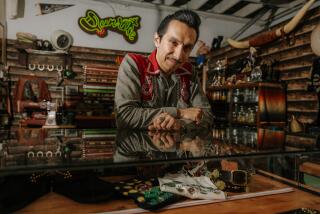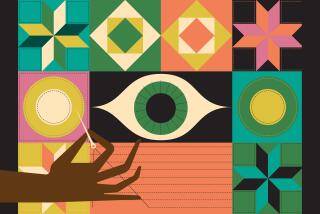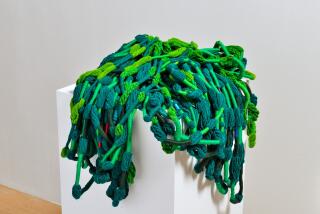DECORATING : Artistâs Blankets Have Western Look Covered
Native American artifacts, from the real thing to repros to modern interpretations, are in demand to lend a Western look in home furnishings.
Pottery, baskets, blankets and rugs handwoven by native artisans past and present are highly prized. Linens from upscale houses such as Ralph Lauren borrow colors and geometric motifs from Indian weavings.
Now thereâs Navi Pesanda, which means my blanket in the Tewa language of northern New Mexico. At about $250 for a blanket and $125 for a throw, they are quasi-authentic.
The colorful wool covers are designed by Terry Enos, a Native American artist who lives on the Santa Clara pueblo near Santa Fe. They are machine-made in Lewiston, Me., for Boucher Boys & The Indian, a company owned by a couple of advertising men, David Dozier of Dallas and Jerry Boucher of Paradise Valley, Ariz.
Dozierâs grandmother, a Native American, and grandfather, a Frenchman, ran a trading post in Santa Fe around the turn of the century where, among other things, they sold Indian blankets.
Those blankets were prized for their beauty. Likewise, most of the 3,000 or so Navi Pesanda blankets sold in the six months since the company opened were bought as decorative accessories, Dozier says.
âPeople spread them on the floor as rugs, hang them up as wall hangings or drape them over the sofa or table,â Boucher says. âSome people are even cutting them up to make pillow covers.â
An end to that is expected when pillows and yard goods are introduced in early 1994.
âThere have always been a few people who collected Indian artifacts, but now lots of people are coming in looking for this sort of thing,â says Helen Kent, who runs a decorating business in Bozeman, Mont. âMovies like âDances With Wolvesâ are helping to fan the interest.â
Kent, charged with decorating the new River Rock Lodge in Big Sky, Mont., plans to use Navi Pesanda blankets in all 72 bedrooms. She also is using the blankets as decorative accessories, along with Navajo rugs, pottery and real and reproduction items such as moccasins, war shirts, beaded apparel, kachina dolls and papoose boards.
In some interiors, she uses Taos drums with rawhide covering and lacing as occasional tables.
âIn an eclectic Western atmosphere, the Indian things bring a room to life,â Kent says. âThe natural dyes, the textures and the colors add great vitality.â
While the Navi Pesanda blankets arenât totally authentic, they lend a special presence. The textiles are all wool, and woven in traditional color combinations. The natural color of sheep wool--black, white, gray and brown--is used with the indigo blues, reds and oranges brought to the Southwest by early settlers from Europe.
The blanket designs are based on linear and abstract geometric patterns associated with Native Americans. But some of the motifs, as well as the names and legends that Dozier has made up, represent artistic license.
âThe frog motif on one of the patterns is artistâs license,â he says. âIt isnât particularly Indian but came out of the mind of the designer.â
Boucher Boys & The Indian had hoped to keep the business within the Native American community, but they had to go far afield to find a weaver--Bates Fabrics Inc., a 143-year-old company facing hard times in Lewiston, Me.
âThey have a marvelous history,â Dozier says. âThey have the looms, and the people who know how to run them, but they were just about out of business.â
Batesâ hard times gave the company the time and motivation to make prototype after prototype of the blankets. Now, the mill has expanded its work force and hopes blankets from the Southwest will boost the fortunes of this mill town in New England.
Boucher Boys & The Indian: Telephone (602) 948-2423.


